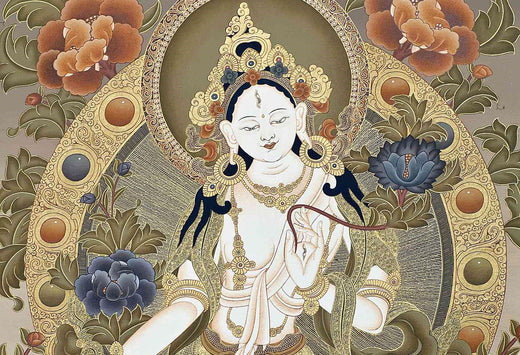
The Radiant Forms of Tara: Green Tara and White Tara
Tara, a prominent figure in Buddhist and Hindu traditions, embodies the essence of compassion, wisdom, and divine feminine energy. Among the various manifestations of Tara, two significant forms stand out: Green Tara and White Tara. In this blog, we will delve into the distinct characteristics and symbolism of these two Taras, celebrating their unique attributes and spiritual significance.
Green Tara: The Rescuer
1. Compassion in Action
Green Tara, often depicted as a young and radiant deity, is renowned for her compassionate nature. She is known as the "Swift Liberator" and is believed to swiftly come to the aid of those in need, rescuing them from suffering and challenges.
2. Symbolism of Green
The vibrant green color that adorns Green Tara signifies her association with youthful energy, growth, and the blooming of spiritual potential. She is often portrayed with one leg outstretched, ready to leap into action, signifying her quick response to alleviate suffering.
3. Mudra of Protection
Green Tara's right hand is often extended in a gesture of generosity and protection, while her left hand holds a blue lotus symbolizing purity. This mudra represents her commitment to safeguarding all sentient beings.
4. Mantra of Compassion
The mantra associated with Green Tara, "Om Tare Tuttare Ture Soha," is chanted to invoke her compassionate energy, wisdom, and protection. It is believed to help overcome obstacles and achieve spiritual goals.
White Tara: The Mother of Longevity
1. Radiant White
White Tara, in contrast, is typically depicted as a mature and serene figure, radiating a sense of peace and tranquility. Her white color symbolizes purity, wisdom, and the illumination of the mind.
2. Healing and Longevity
White Tara is often associated with healing and longevity. She is revered as the "Mother of All Buddhas" and is believed to grant physical and spiritual healing, as well as a long and healthy life.
3. Seven Eyes of Wisdom
White Tara is often depicted with seven eyes: three on her face and one on each of her palms and feet. These eyes symbolize her all-seeing wisdom, which helps her guide and protect beings on their spiritual journey.
4. Mantra of Healing
The mantra associated with White Tara, "Om Tare Tuttare Ture Mama Ayuh Punya Jnana Pustim Kuru Svaha," is chanted to invoke her blessings for healing, longevity, and wisdom.
Harmony and Balance
While Green Tara and White Tara may appear distinct in their attributes and symbolism, both emanate from the same source of enlightened compassion. Together, they represent the harmonious balance of action and contemplation, compassion and wisdom, and the transformative power of the divine feminine.
The radiant forms of Tara, Green Tara and White Tara, embody the boundless compassion and wisdom of the divine feminine in Buddhism. Whether seeking swift rescue from life's challenges or the blessings of healing and longevity, these Taras offer solace and guidance on the spiritual journey. As we explore their unique qualities and symbolism, we find inspiration to cultivate compassion, wisdom, and balance in our own lives, following in the footsteps of these enlightened beings.